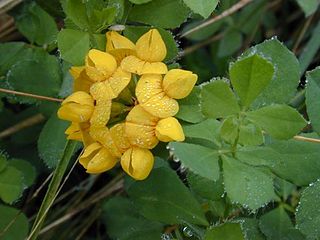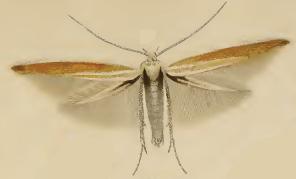
Lotus, a latinization of Greek lōtos (λωτός), is a genus of flowering plants that includes most bird's-foot trefoils and deervetches and contains many dozens of species distributed worldwide. Depending on the taxonomic authority, roughly between 70 and 150 are accepted. Lotus is a genus of legumes and its members are adapted to a wide range of habitats, from coastal environments to high altitudes.

Lotus corniculatus is a flowering plant in the pea family Fabaceae, native to grasslands in temperate Eurasia and North Africa. Common names include common bird's-foot trefoil, eggs and bacon, birdsfoot deervetch, and just bird's-foot trefoil, though the latter name is often also applied to other members of the genus.

Lotus pedunculatus, the big trefoil, greater bird's-foot-trefoil or marsh bird's-foot trefoil, is a member of the pea family (Fabaceae).

The dingy skipper is a butterfly of the family Hesperiidae. It ranges from Europe across Asia Minor and Central Asia to the Amur region. Erynnis tages favours open grassy habitats up to 2,000 metres above sea level. The insect flies in two generations from May–June and July–August but in northern regions and at the high altitudes, there is only a single generation. Larval host plants in Europe are Eryngium, Lotus, Coronilla, Medicago, Hippocrepis etc. Subspecies are little defined and include E. t. unicolor Freyer, 1852 found in Transcaucasia.
Bird's foot may refer to:
NVC community H7 is one of the heath communities in the British National Vegetation Classification system. It is one of two communities categorised as maritime heaths.
British NVC community MG5 is one of the mesotrophic grassland communities in the British National Vegetation Classification system. It is one of four such communities associated with well-drained permanent pastures and meadows.

Corniculate, an Anglicisation of the Latin diminutives corniculata, corniculatum, and corniculatus, describes an object possessing hornlike extensions. The root is Latin cornu = "horn". The term is used to describe the shape of the corniculate cartilages of the larynx. The horned puffin is named for its distinctive horn-like coloration. Likewise Oxalis corniculata is named for its two erect capsules, which resemble little horns, and the bird's-foot trefoil Lotus corniculatus and goat's horn mangrove Aegiceras corniculatum are named for their horn-shaped fruits.
Trefoil is a graphic form composed of three lobes.
William Frederick Grant was a Canadian plant geneticist, biosystematist, educator, and environmental advocate who developed higher plant species for monitoring and testing for mutagenic effects of environmental pollutants. He has carried out research on the genetics of species of the genus Lotus (Leguminosae) and the forage species Lotus corniculatus developing an innovative procedure for increasing seed production in the legume birdsfoot trefoil.
NVC community CG3 is one of the calcicolous grassland communities in the British National Vegetation Classification system. It is one of four communities of rank, tussocky grassland associated with low levels of grazing, within the lowland calcicolous grassland group.
NVC community CG6 is one of the calcicolous grassland communities in the British National Vegetation Classification system. It is one of four communities of rank, tussocky grassland associated with low levels of grazing, within the lowland calcicolous grassland group.

Oncocera semirubella is a small moth of the family Pyralidae. It is found in Europe, including the British Isles.
Coleophora squamella is a moth of the family Coleophoridae. It is found from the Czech Republic to Sardinia and Italy and from France to Romania. It is also known from Turkey.

Coleophora discordella is a moth of the family Coleophoridae. It was first described by Philipp Christoph Zeller in 1849 and is found in Europe.

Polruan to Polperro is a coastal Site of Special Scientific Interest (SSSI) and Special Area of Conservation (SAC) in south-east Cornwall, England, UK, noted for its biological interest. It contains a wide variety of plant species and is a site for populations of breeding birds.
Slender trefoil is a common name for several plants and may refer to:

Scythris picaepennis is a moth of the family Scythrididae first described by Adrian Hardy Haworth in 1828. It is found in Europe.
Scythris siccella is a moth of the family Scythrididae first described by the German entomologist Philipp Christoph Zeller in 1839, found in Europe.








